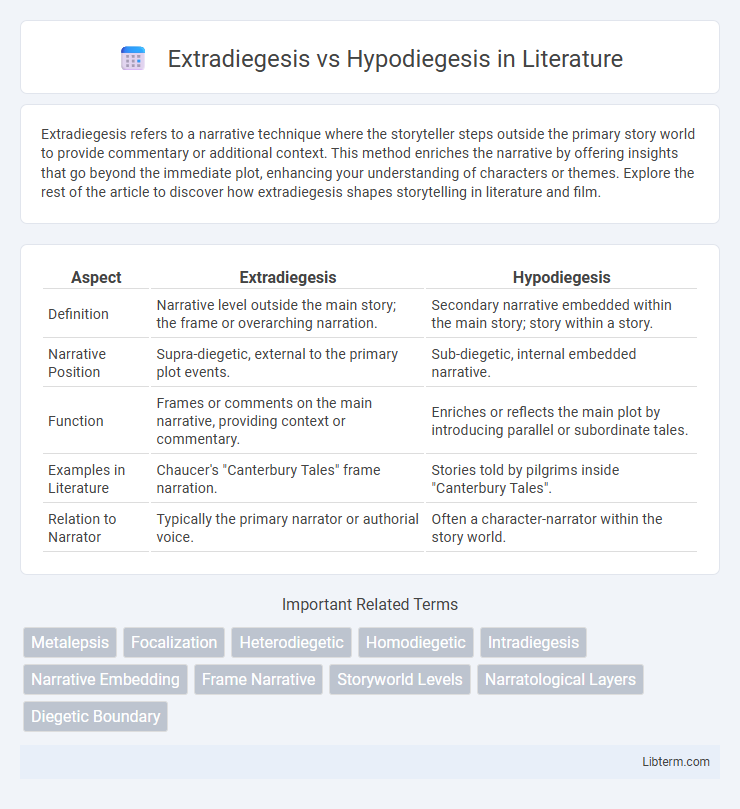Extradiegesis refers to a narrative technique where the storyteller steps outside the primary story world to provide commentary or additional context. This method enriches the narrative by offering insights that go beyond the immediate plot, enhancing your understanding of characters or themes. Explore the rest of the article to discover how extradiegesis shapes storytelling in literature and film.
Table of Comparison
| Aspect | Extradiegesis | Hypodiegesis |
|---|---|---|
| Definition | Narrative level outside the main story; the frame or overarching narration. | Secondary narrative embedded within the main story; story within a story. |
| Narrative Position | Supra-diegetic, external to the primary plot events. | Sub-diegetic, internal embedded narrative. |
| Function | Frames or comments on the main narrative, providing context or commentary. | Enriches or reflects the main plot by introducing parallel or subordinate tales. |
| Examples in Literature | Chaucer's "Canterbury Tales" frame narration. | Stories told by pilgrims inside "Canterbury Tales". |
| Relation to Narrator | Typically the primary narrator or authorial voice. | Often a character-narrator within the story world. |
Introduction to Diegesis in Narrative Theory
Extradiegesis and hypodiegesis represent different narrative layers within diegesis, where extradiegesis denotes the primary narrative level, often the storyteller's own voice, and hypodiegesis refers to embedded or subordinate narratives, such as stories within stories. In narrative theory, understanding these levels is crucial for analyzing how narratives structure time, perspective, and the reliability of the narrator. Diegesis itself encompasses the internal world of the story, defining the boundary between the narrative's universe and the external reality.
Defining Extradiegesis
Extradiegesis refers to narrative elements or commentary that exist outside the primary story world, often providing background information or an external perspective to the diegetic events. This narrative technique contrasts with hypodiegesis, which involves embedded stories or narratives within the main diegesis, creating multiple layers of storytelling. Defining extradiegesis is crucial for understanding how storytellers manipulate narrative distance and focalization to influence the audience's perception of the main plot.
Understanding Hypodiegesis
Hypodiegesis refers to a narrative technique where a secondary or embedded story is told within the framework of a primary narrative, often providing background or context to the main plot. This method enriches the storytelling by offering multiple layers of meaning and perspective, allowing for complex character development and thematic depth. Understanding hypodiegesis is crucial in literary analysis to fully grasp the interplay between the dominant story and its subordinate narrative elements.
Key Differences Between Extradiegesis and Hypodiegesis
Extradiegesis refers to a narrative perspective where the storyteller exists outside the story world, providing an overarching account without participating in the events. Hypodiegesis involves a story embedded within another narrative, where characters narrate secondary tales inside the primary story framework. The key difference lies in their narrative levels: extradiegesis operates as the main, external narrative layer, while hypodiegesis functions as an internal, subordinate story layer embedded within the primary narrative.
Narrative Levels and Story Worlds
Extradiegesis refers to the narrative level where the narrator exists outside the story world, providing an overarching perspective beyond the characters' experiences. Hypodiegesis occurs within a subordinate, embedded narrative level, representing a story told inside another story world by characters or narrators within the primary narrative. These distinctions between extradiegetic and hypodiegetic levels highlight the layered complexity of narrative structures and the shifting boundaries between story worlds.
Functions of Extradiegetic Narration
Extradiegetic narration functions as a primary storytelling voice positioned outside the story's universe, providing an objective perspective that shapes the audience's understanding and interpretive framework. It guides the narrative by offering commentary, context, and interpretative cues without being a character within the narrative world. This external narrative layer enhances thematic depth and controls the information flow, influencing how the story's events and characters are perceived.
Role of Hypodiegetic Narratives
Hypodiegetic narratives function as embedded stories within the primary narrative, enriching the main plot by providing background, character motivations, or thematic depth. These secondary tales create a layered storytelling experience that enhances the complexity of the overall narrative structure. By serving as a narrative device, hypodiegesis bridges various temporal and spatial dimensions, enabling diverse perspectives and deeper audience engagement.
Examples in Literature and Film
Extradiegesis refers to narratives told outside the story world, such as a film narrator who explains the plot without being part of the story, exemplified by the voice-over in *Fight Club*. Hypodiegesis occurs as an embedded story within the main narrative, like the fairy tale recounted in *The Princess Bride* or the dreams narrated in *Inception*. These narrative techniques enhance storytelling by offering multiple layers of perspective and deepening audience engagement through inner or external commentary.
Importance in Storytelling Analysis
Extradiegesis represents the narrator's voice outside the story world, offering critical commentary and framing that shapes audience perception, while hypodiegesis involves embedded narratives within the main story, enriching the plot through layered storytelling. Recognizing the distinction between extradiegesis and hypodiegesis enhances storytelling analysis by clarifying narrative levels and the sources of information, which aids in understanding the structure and depth of a narrative. This distinction is crucial for interpreting how stories manipulate point of view, reliability, and thematic complexity to engage readers or viewers.
Conclusion: Navigating Narrative Layers
Extradiegesis and hypodiegesis represent distinct narrative levels that structure complex storytelling, with extradiegesis referring to the primary narrative frame and hypodiegesis indicating embedded or subordinate stories. Navigating these layers enhances comprehension of narrative complexity by revealing how stories interact and influence each other within a text. Mastery of these concepts allows readers to discern shifts in perspective, temporal frames, and thematic depth, enriching interpretation and critical analysis.
Extradiegesis Infographic

 libterm.com
libterm.com